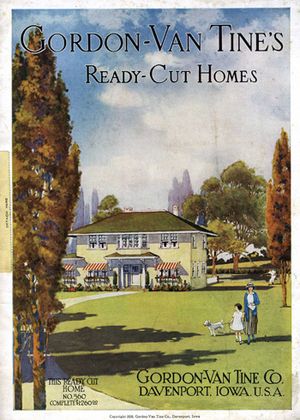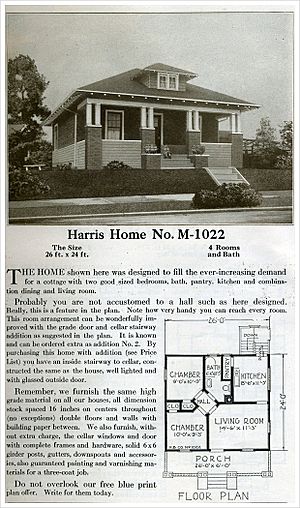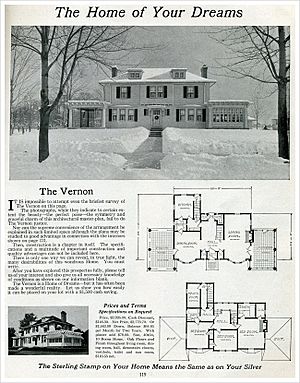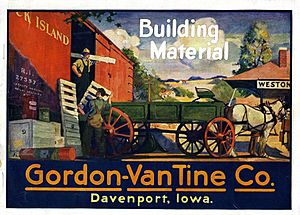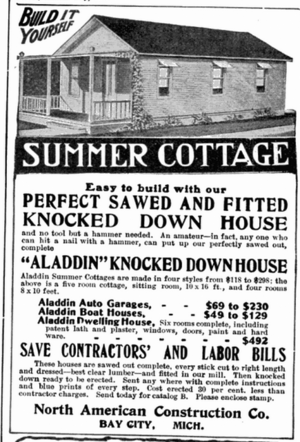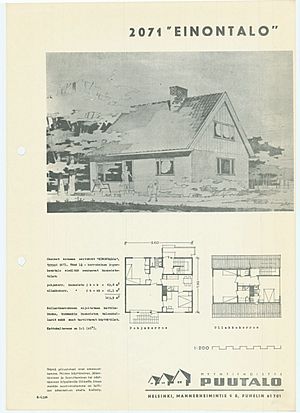Kit house facts for kids
Kit houses were a cool way people built homes in the early 1900s. They were also called mail-order homes or catalog homes. Imagine ordering your entire house from a catalog, just like you might order clothes or electronics today!
These houses were popular in the United States and Canada. Companies would sell many different house styles. You could choose from a small bungalow or a grand Colonial style home. The company would then send you all the materials needed to build it. Things like bricks or concrete for the foundation were usually not included. You would arrange for those locally.
Contents
How Kit Houses Were Designed
Kit houses were built to be strong, permanent homes. They were not like temporary shelters. Each piece of wood was already numbered and cut to the right size. This meant builders didn't need to measure or cut wood on site. This saved a lot of time and materials.
Companies said you could save 30% to 40% compared to traditional building. They bought wood and other parts in huge amounts. Their factories had special machines and skilled workers. They could cut tricky pieces like roof rafters and staircases perfectly.
A kit house order usually included:
- Pre-cut wood for floors, walls, and roofs.
- Doors and windows.
- Hardware like nails and hinges.
- Paint for the outside.
You could often add plumbing, electrical, and heating systems for an extra cost. Even though parts were standard, you could still make your house unique. Many models had different floor plans. You could choose different outside finishes like wood siding or stucco. You could also add porches, sunrooms, or built-in cabinets.
Delivery and Building Your Home
Building materials for a kit house could fill one or two boxcars on a train. These cars would travel from the company's factory to your town. They would be unloaded at a train siding or freight yard.
Once the materials arrived, you could hire a local carpenter to build the house. Or, if you were good with tools, you could build it yourself! It usually took several weeks or a few months.
The finished kit houses looked just as good as, or even better than, homes built the old way. They were often cheaper too. This was because you saved money on labor costs. Also, buying high-quality wood from a big company was often cheaper than from a local lumber yard. Some companies even offered discounts or good mortgage plans. The total cost to build a kit house was usually about double the catalog price. This included the foundation and labor.
Making Your Kit House Unique
Some companies let you buy just the house plans. Then you would buy all the materials locally. Sears, a big kit house seller, even encouraged this. They wanted their "Modern Homes" to be affordable.
Companies also allowed changes to their designs. You could get a reversed version of a house plan. You could even send in your own blueprints to Sears. They would then send you the pre-cut materials for your custom design!
You could also choose the quality of materials. Sears offered "Honor Bilt" homes with the best materials. They also had "Standard Built" homes, which were better for warmer places. These didn't keep heat in as well.
How Kit Houses Were Advertised
Kit houses were advertised in many ways. You could find catalogs at lumber yards and hardware stores. Big stores like Sears and Wards published their own mail-order catalogs. Ads also appeared in popular magazines and newspapers. Magazines like Saturday Evening Post and National Geographic featured them.
You could even visit a company's factory to see model homes. Or you could inspect kit houses already built in your area.
Kit houses appealed to many people. This included regular workers and even wealthy people. For example, in 1928, Walt Disney and his brother Roy built two kit houses. They bought them from Pacific Ready Cut Homes in Los Angeles.
The popularity of kit houses was even shown in movies! In the 1920 silent comedy One Week, Buster Keaton tries to build a kit house. But everything goes wrong in a funny way!
Kit House Companies
Many companies sold kit houses. They also sometimes offered simple "industrial" buildings or summer cottages. You could even buy kits for garages, duplexes, apartment buildings, barns, and outhouses.
Canada
Two of the biggest sellers in Canada were:
- Canadian Aladdin Co. Ltd. This company was based in Michigan, USA, but had a Canadian office in Toronto. They sold kit homes across Canada from 1905 to 1952. Their homes were truly pre-cut and easy to put together. They even promised a refund if you found a knot in their high-quality wood!
- The T. Eaton Co. Ltd. Eaton's was a huge mail-order store in Canada. They sold house kits from 1910 to 1932. Their kits were mainly available in Western Canada. Eaton's sold over 40 different house plans. Their houses were sold as kits, but they were not pre-cut.
United States
More than 100,000 kit homes were built in the United States between 1908 and 1940. Some well-known companies included:
- Aladdin Homes (Bay City, Michigan)
- Gordon-Van Tine Homes (Davenport, Iowa)
- Harris Homes (Chicago, Illinois)
- Sears Modern Homes (Chicago, Illinois)
- Wardway Homes (Montgomery Ward, Chicago, Illinois)
Many kit house companies stopped selling homes before, during, or after the Great Depression. Some went out of business. Others went back to just selling building materials. For example, Sears and Montgomery Ward stopped their mortgage programs. This made selling kit homes less profitable for them.
After World War II, most people started buying new, affordable homes in large housing developments. So, the popularity of kit houses faded.
Today, you can still find pre-cut log home and geodesic dome kits. Lindal Cedar Homes, a company started in 1945, still sells pre-cut home packages around the world. For a few years, Lowe's also sold plans and materials for small homes called Katrina Cottages. These were designed to help people who lost homes in Hurricane Katrina. However, these cottages faced problems with local governments and were eventually stopped.
|


